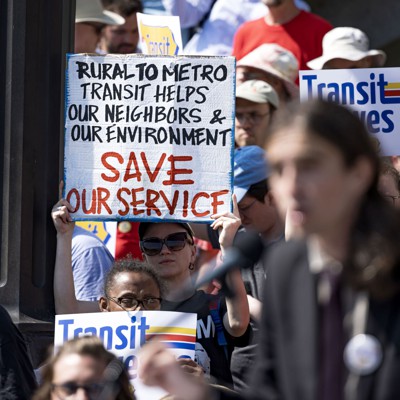1.5 million fewer people rode Metro in June compared to a year earlier – LAist

Report on Los Angeles Metro Ridership Trends and Sustainable Development Implications
Executive Summary
An analysis of Los Angeles Metro ridership data for June 2025 reveals a significant decline in comparison to previous periods. This reduction coincides with increased federal immigration enforcement activities, public protests, and specific service disruptions. The trend poses considerable challenges to the achievement of several key United Nations Sustainable Development Goals (SDGs), particularly those related to sustainable cities, reduced inequalities, and access to economic opportunities.
Systemwide Ridership Analysis: June 2025
Data indicates a notable contraction in the use of public transit, undermining progress toward SDG 11 (Sustainable Cities and Communities), which advocates for safe, affordable, and sustainable transport systems for all.
- Overall ridership decreased by approximately 6% in June 2025 compared to June 2024.
- A more pronounced drop of over 13% (3.7 million riders) was observed between May 2025 and June 2025.
- While a seasonal decrease is expected, the 2025 May-to-June decline (13%) was nearly double the dip observed in the previous year (7%).
Analysis of Contributing Factors and SDG Impact
Several factors are correlated with the ridership decline, each with distinct implications for sustainable development.
- Immigration Enforcement and Community Climate: Increased visibility of federal immigration enforcement has reportedly created a climate of fear, discouraging use of public transit. This directly impacts SDG 10 (Reduced Inequalities) by potentially limiting the mobility and access to essential services for immigrant and vulnerable populations. It also compromises the objective of SDG 11 to create inclusive and safe public spaces.
- Service Disruptions: The 70-day closure of the D Line for maintenance contributed to the overall reduction, highlighting the need for resilient infrastructure to support SDG 11.2 (access to sustainable transport systems).
- Protests and Curfews: Anti-ICE protests and a related curfew in downtown Los Angeles led to the re-routing of major bus lines, disrupting reliable access to transportation and affecting progress on SDG 8 (Decent Work and Economic Growth) for commuters who rely on these routes for employment.
Route-Specific Performance
Decline in Key Transit Corridors
The decline was not uniform across the system, with critical routes serving populous areas seeing significant drops. This pattern suggests a disproportionate impact on communities reliant on public transport, further exacerbating challenges outlined in SDG 10.
- Bus routes 16, 18, 51, and 70, which were re-routed during downtown protests, experienced a ridership decline of approximately 10% year-over-year.
- Among rail lines, the C Line saw the largest relative decrease, with 26% fewer riders (a loss of nearly 150,000 people) between June 2024 and June 2025.
Growth on the K Line: A Positive Indicator for SDG 11
In contrast to the general trend, the K Line demonstrated significant growth, aligning with the goals of strategic infrastructure investment.
- Ridership on the K Line more than doubled over the year.
- A 35% increase in riders was recorded between May and June 2025 alone.
- This growth is attributed to the early June opening of the LAX Metro Transit Center, which enhances connectivity and directly supports SDG 11.2 by improving access to a major economic and transport hub.
Implications for Peace, Justice, and Strong Institutions (SDG 16)
The events surrounding the ridership decline touch upon the principles of SDG 16, which calls for effective, accountable, and inclusive institutions. Reports of immigration enforcement activity near or at transit stations raise concerns about public trust in civic institutions and the accessibility of public services for all residents, regardless of status.
- Immigration officers were reported at the El Monte train station and the Metro Harbor Gateway Station.
- In response to protest-related service disruptions, the Metro Board has directed the agency to update protocols for station closures to ensure passengers are not left stranded, reflecting a move toward more accountable governance (SDG 16.6).
Data Limitations
This report is based on system-level and route-level ridership data. A more granular analysis using boarding data from individual stops would be required to fully understand the specific geographic and demographic patterns of the ridership decline and to formulate targeted policies that advance the Sustainable Development Goals.
SDGs Addressed in the Article
SDG 11: Sustainable Cities and Communities
- The article’s primary focus is on the public transportation system (buses and trains) in a major urban area, Los Angeles. It discusses issues of ridership, access, and infrastructure, which are central to creating sustainable cities. The analysis of LA Metro’s performance, including the decline in riders on some routes and growth on others due to new infrastructure like the “LAX Metro Transit Center,” directly relates to the goal of making cities inclusive, safe, resilient, and sustainable.
SDG 10: Reduced Inequalities
- The article strongly suggests that the decline in public transit ridership is linked to “a more visible uptick in federal immigration enforcement.” This implies that a specific vulnerable group—immigrants who may fear encounters with ICE—is disproportionately affected. By creating a climate of fear, these enforcement activities can reduce access to essential services for this community, thereby exacerbating inequality within the city.
SDG 16: Peace, Justice and Strong Institutions
- The article touches on the role of institutions and justice. It mentions “anti-ICE protests,” the presence of “immigration officers” at transit stations, and Metro’s institutional response to these events, such as updating “protocols for station closures amid protests.” This relates to building effective and accountable institutions (Metro) and ensuring public access and safety in the face of law enforcement activities that may be perceived as unjust or intimidating by parts of the community.
Specific SDG Targets Identified
Target 11.2: Provide access to safe, affordable, accessible and sustainable transport systems for all
- This target is central to the article. The discussion revolves around access to and use of the LA Metro system. The 6% year-over-year drop in ridership suggests a decline in the system’s accessibility or perceived safety for its users. The article explicitly connects this drop to factors that make the system feel unsafe for vulnerable populations, stating the decline “coincides with a more visible uptick in federal immigration enforcement.” Conversely, the success of the K Line, where ridership “more than doubled” after the opening of the LAX Metro Transit Center, shows how infrastructure improvements can enhance access.
Target 10.2: Empower and promote the social, economic and political inclusion of all, irrespective of origin or other status
- The article implies that the fear of immigration enforcement is leading to the exclusion of a specific group. When people avoid public transportation, their ability to travel to work, school, and access other essential services is diminished, hindering their social and economic inclusion. The article notes that the ridership drop occurred as anti-ICE protests and enforcement became more visible, suggesting a direct impact on the inclusion of the immigrant community.
Target 16.3: Promote the rule of law and ensure equal access to justice for all
- The presence of ICE agents at or near transit stations, such as the “El Monte train station” and “Metro Harbor Gateway Station,” can be seen as a barrier to equal access to public services. For individuals with precarious immigration status, the fear of detention prevents them from moving freely and utilizing public infrastructure. This creates an environment where access to a fundamental city service is not equal for all residents, undermining the principle of equal access.
Indicators for Measuring Progress
Indicators for Target 11.2
- The article provides direct, quantifiable indicators for measuring progress towards this target. These include:
- Overall public transit ridership: The article analyzes “Metro ridership data” and reports specific figures, such as a drop of “3.7 million people” between May and June.
- Percentage change in ridership: Specific metrics are used, such as the “6% fewer people” who rode in June compared to the previous year and the “13%” fall in ridership from May to June.
- Ridership data for specific routes: The analysis points to route-level changes, noting that “Bus routes 16, 18, 51 and 70 had around 10% fewer riders” and the “C Line saw the largest relative drop in riders… There were 26% fewer riders.”
- Impact of new infrastructure on ridership: The success of the K Line, with ridership “more than doubling,” serves as an indicator of how infrastructure projects can improve access.
Indicators for Target 10.2
- The article implies an indicator for measuring inclusion. While it states that “ridership numbers don’t tell the whole story” and data is not broken down by demographic, the primary implied indicator is the correlation between the decline in ridership and the increase in immigration enforcement activities. The sharp drop in ridership serves as a proxy indicator for the exclusion of the immigrant community, which is noted to be fearful of using the system.
Indicators for Target 16.3
- The article provides qualitative indicators related to justice and safety. These include:
- Number of reported incidents of law enforcement presence at transit hubs: The article mentions specific instances, such as “reports of ICE officers” at the Metro Harbor Gateway Station and officers asking about immigration status at the “El Monte train station.” Tracking the frequency of such events serves as an indicator of potential barriers to access.
SDGs, Targets, and Indicators Analysis
| SDGs | Targets | Indicators |
|---|---|---|
| SDG 11: Sustainable Cities and Communities | 11.2: Provide access to safe, affordable, accessible and sustainable transport systems for all, with special attention to the needs of those in vulnerable situations. |
|
| SDG 10: Reduced Inequalities | 10.2: Empower and promote the social, economic and political inclusion of all, irrespective of origin or other status. |
|
| SDG 16: Peace, Justice and Strong Institutions | 16.3: Promote the rule of law and ensure equal access to justice for all. |
|
Source: laist.com

What is Your Reaction?
 Like
0
Like
0
 Dislike
0
Dislike
0
 Love
0
Love
0
 Funny
0
Funny
0
 Angry
0
Angry
0
 Sad
0
Sad
0
 Wow
0
Wow
0









































































